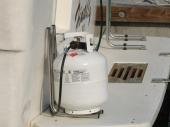Dougcole
Guru
We have a Weber Q on our boat, which I like, but I hate the little 1 pound gas bottles. They are expensive, not environmentally sound and rust like crazy. So I am considering upgrading to a refillable 5 lb bottle.
The only propane on our boat is the grill. I know a little about marine propane systems, the dedicated storage locker needs to be vented, they need a solenoid etc. But does that apply to a portable tanks as well? I'd like to keep it in my summer kitchen (which is vented) and take it out when I use it. I would not keep it attached to the grill.
Thoughts?
Thanks.
The only propane on our boat is the grill. I know a little about marine propane systems, the dedicated storage locker needs to be vented, they need a solenoid etc. But does that apply to a portable tanks as well? I'd like to keep it in my summer kitchen (which is vented) and take it out when I use it. I would not keep it attached to the grill.
Thoughts?
Thanks.




